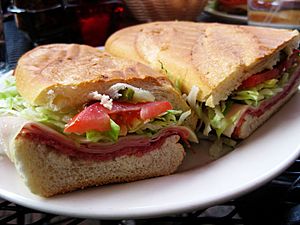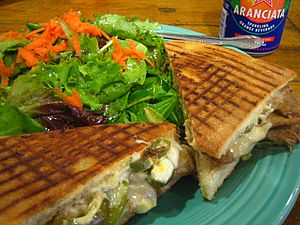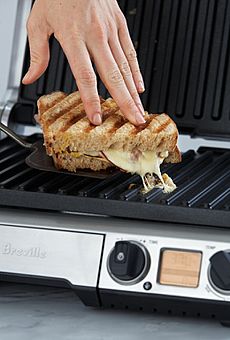Panini (sandwich) facts for kids

A typical panini with salami, mortadella, tomatoes and lettuce
|
|
| Alternative names | Panini sandwich, panino, panino imbottito |
|---|---|
| Type | Sandwich |
| Place of origin | Italy |
| Serving temperature | Warm or room temperature |
| Main ingredients | Bread (not sliced bread), filling (meat, cheese, vegetables) |
A panini is a yummy sandwich often made with special Italian bread. The word "panini" comes from Italy and means "small bread rolls." These sandwiches are usually served warm after being grilled or toasted.
In many places, a panini is a grilled sandwich made with different kinds of bread. Some popular breads for panini include baguette, ciabatta, and focaccia. The bread is cut open and filled with tasty ingredients like cheese, ham, salami, or other foods. After filling, it's often pressed on a special grill to make it warm and a little crispy.
Contents
What's in a Panini's Name?
The word panini comes from the Italian word panino. Panino means "bread roll" and is a smaller version of the word pane, which means "bread." If you say panino imbottito in Italian, it means "stuffed panino," which is a sandwich. But often, people just say panino to mean a sandwich.
In English-speaking countries, people often use panini as if it's a single sandwich. So, you might hear someone say "I want a panini." If they want more than one, they might say "panini" or "paninis." In Italian, panino is for one, and panini is for more than one.
The History of Panini Sandwiches
Even though panini became very popular in the United States in the 1950s, and a similar sandwich was mentioned in an Italian cookbook way back in the 1500s, they really took off in the 1970s and 1980s. This happened in bars in Milan, Italy, which were called paninoteche. Soon, trendy restaurants in the U.S. started selling panini, each with their own special twists.
In the 1980s, a youth culture in Italy called paninaro even grew up around these sandwich bars. These young people loved fashion and showing off cool new products from the early 1980s. They often hung out at places like Al Panino in Milan, which was one of Italy's first American-style fast food spots.
How Panini Grills Work
A panini press, also known as a panini grill, is a special electric machine used to heat sandwiches. It has a hot bottom plate and a hot top plate that presses down on the food. This grill makes sure the sandwich gets warm all the way through. It also gives the outside a nice, crispy finish and often leaves cool grill marks. You can use it for sandwiches, meats, vegetables, and other yummy foods.
See also
 In Spanish: Panini (sándwich) para niños
In Spanish: Panini (sándwich) para niños



